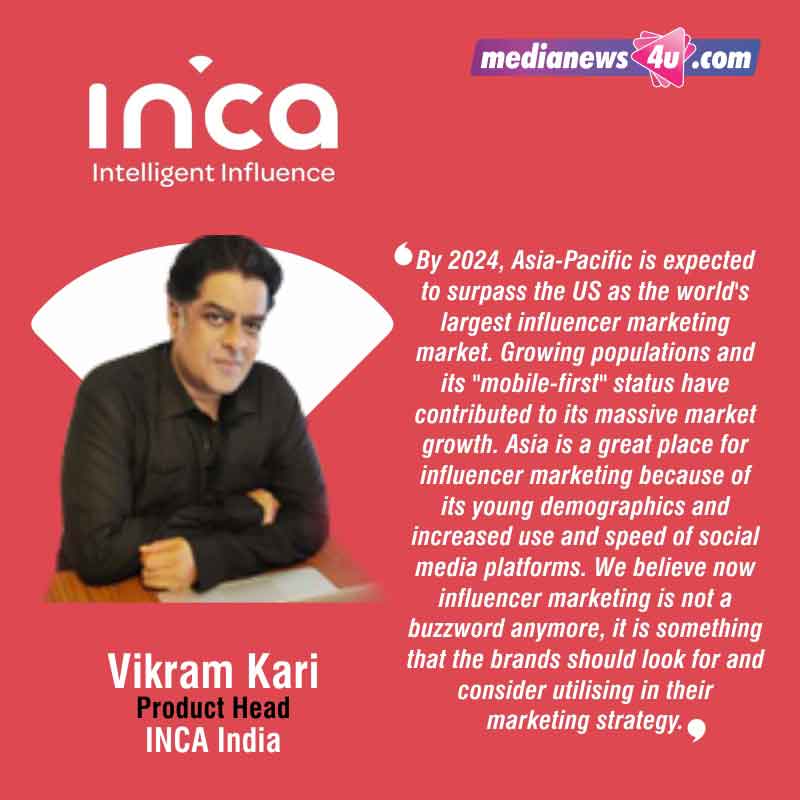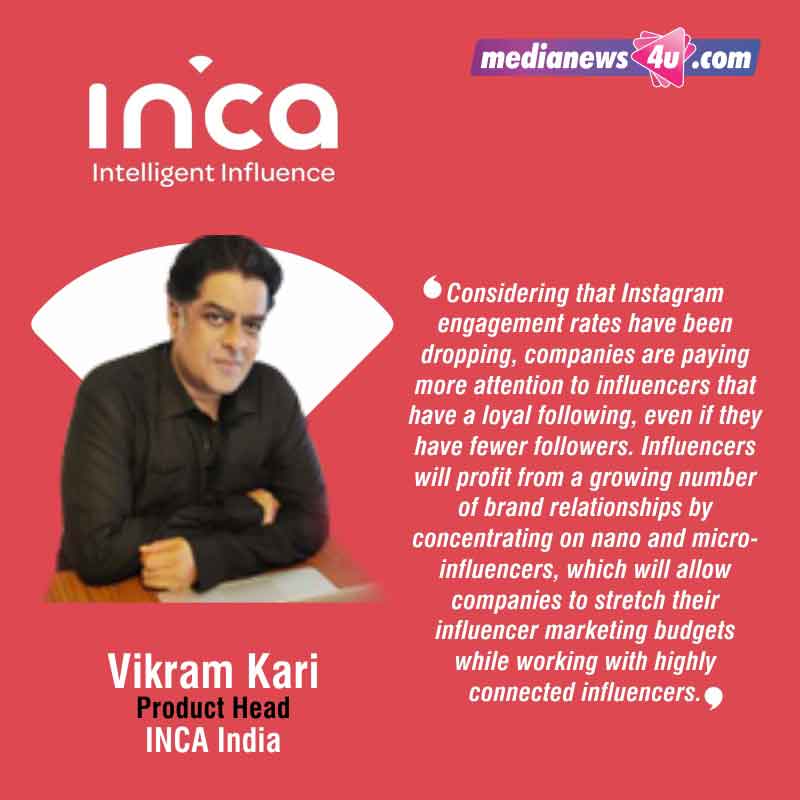INCA is GroupM’s brand-safe influencer and content marketing solution. Using proprietary technology, in-house experts, and a network of industry-leading partners, INCA provides influencer selection and content production services, as well as content distribution at scale across social and publisher platforms. Their creator partnerships, campaign workflows, and active reporting tools assure full control and brand safety for advertisers and their agencies while helping them optimize their campaigns towards measurable business outcomes. INCA is part of GroupM, the world’s largest media investment company, and has operational teams active in 20 markets around the world.
In an exclusive chat with Medianews4U Vikram Kari, Product Head, INCA India speaks on Influencer Marketing, trends in India and globally, new guidelines by ASCI, and much more…
Influencer marketing is the buzzword today, your thoughts?
As the lockdown reached its climax, people who were stranded at home spent time on social media, playing games, and streaming material. In response to the increase in time spent on the internet, companies began working more closely with social media influencers.
Established companies, as well as start-ups, are investing in this influencer marketing since it provides a path to brand recognition and attracts a large audience. This is especially true with the TikTok boom which allows creators to go viral easily and promotes smaller influencers. Influencers are also able to target niche consumers, which is something many companies are looking for.
By 2024, Asia-Pacific is expected to surpass the US as the world’s largest influencer marketing market. Growing populations and its “mobile-first” status have contributed to its massive market growth. Asia is a great place for influencer marketing because of its young demographics and increased use and speed of social media platforms.
We believe now influencer marketing is not a buzzword anymore, it is something that the brands should look for and consider utilizing in their marketing strategy.

Today thanks to the crisis, lockdown Influencer endorsements or marketing has become a necessity for most brands, how are you viewing this trend in India and globally?
Initially, there were concerns about how brands and influencers would fare during the pandemic, with creators not being able to record content from gyms, bars, restaurants, and other venues. However, the reality is that pandemic has been a catalyst for advancement in influencer marketing. Influencers are valued more than ever before by marketers. Every marketing plan relies on creators, and partnerships are increasingly regarded as strategic rather than transactional.

Due to the closure of brick-and-mortar stores and the cancellation of physical events, marketers have to rethink how to reach customers. In order to break through the noise and impact consumers, brands realized they would need to leverage internet platforms wisely and smartly. As a result, they turned to creators for help. To a great extent, this was because they were able to successfully adjust to new and unexpected circumstances.
ASCI recently enforced new guidelines, brands/influencers now have to prominently display whether the content is an advertisement or paid for content? How is INCA incorporating these guidelines for their clients?
The newly introduced guidelines are a welcome initiative towards bringing some self-regulation for an otherwise unorganized industry.
The onus of compliance with these guidelines is on both – brands and creators. While bigger brands have always adhered to the ‘paid partnership’ disclosure, it is the newer clients and content creators that often need to be aligned. The first step for us is to educate clients and content creators about what is to be done, why, and how. Brand safety being our number one priority, we make sure that creators across our campaigns follow these mandates.

What is the USP of INCA?
Data-based planning and Guaranteed Outcomes from our USP. We want clients to buy influencer plans based on ROI and not vanity metrics.
As part of GroupM, the world’s largest media buyer, and WPP, the world’s leading media investment company, we have access to unrivaled scale, resources, partners, and capabilities that help us maximize results for our clients while assuring brand safety and client control. We have operational teams with local expertise in 25 markets across 4 regions around the world, each with the ability to coordinate global scale across markets for any campaign. Using a combination of technology, creativity, and mass distribution, we optimize the return on influencer marketing and content investment.
Your recent partnership with Hanson Robotics, can you elaborate on this partnership?
We’ve partnered with Hanson Robotics, the company behind the creation of the artificial intelligence (AI) robot Sophia in the Asia Pacific. With this partnership, Sophia joins INCA’s global network of content creators and influencers to help brands create influential content that brings brand stories to life. Brands in the APAC region can now engage Sophia as their influencer partner to create relevant and engaging bite-sized content and connect with brand audiences across various social media platforms. The collaboration with Sophia showcases the marvels of A.I. in a humanoid form that exemplifies the technological achievements of our times; creating a new channel of creativity for brands to use A.I. influencers to build human connections with brands.

Where do you see Influencer Marketing in the coming years?
Influencer marketing will continue to grow in the coming years as the popularity of content creators, consumer demand for two-way interaction, and marketing budgets rise. 63% of businesses expect to raise their influencer marketing spending in 2021. An estimated $15 billion business is expected to emerge from influencer marketing by 2022, according to Business Insider’s latest projections.
Additionally, micro and nano influencers will form a greater part of the marketing mix. Research by Later and Fohr found that the highest engagement rates were seen among micro-influencers, particularly those with fewer than 25,000 followers. Considering that Instagram engagement rates have been dropping, companies are paying more attention to influencers that have a loyal following, even if they have fewer followers. Influencers will profit from a growing number of brand relationships by concentrating on nano and micro-influencers, which will allow companies to stretch their influencer marketing budgets while working with highly connected influencers.


















